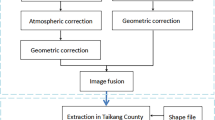Abstract
Dense semantic segmentation is an important task for remote sensing image analyzing and understanding. Recently deep learning has been applied to pixel-level labeling tasks in computer vision and produces state-of-the-art results. In this work, a fully convolutional network (FCN), which is a variant of convolutional neural network (CNN), is employed to address the semantic segmentation of high resolution aerial images. We design a skip-layer architecture that combines different layers of features in aerial images. This structure integrates the semantic information from deep layer and appearance information from shallow layer to make better use of the aerial image features. Moreover, the FCN can be trained end-to-end and produce segmentation output correspondingly-sized as the input image. Our model is trained on the extended GE-4 aerial image dataset to adapt FCN to the aerial image segmentation task. A full-resolution semantic segmentation is produced for each testing aerial image. Experiments show that our method obtains improvement in accuracy compared with several other methods.
Access this chapter
Tax calculation will be finalised at checkout
Purchases are for personal use only
Similar content being viewed by others
References
Zhou, H., Yua, Y., Shi, C.: Object tracking using SIFT features and mean shift. Comput. Vis. Image Underst. 113(3), 345–352 (2009)
Viola, P.: Robust real time object detection. In: International Workshop on Statistical and Computational Theories of Vision – Modeling, Learning, Computing, and Sampling 87 (2001)
Krizhevsky, A., Sutskever, I., Hinton, G.E.: ImageNet classification with deep convolutional neural networks. In: International Conference on Neural Information Processing Systems, pp. 1097–1105. Curran Associates Inc. (2012)
Lin, G., Shen, C., Reid, I., et al.: Efficient piecewise training of deep structured models for semantic segmentation. In: IEEE Conference on Computer Vision and Pattern Recognition (2016)
Penatti, O.A.B., Nogueira, K., dos Santos, J.A.: Do deep features generalize from everyday objects to remote sensing and aerial scenes domains? In: IEEE CVPR Workshops, pp. 44–55 (2015)
Maggiori, E., Tarabalka, Y., Charpiat, G., et al.: Convolutional neural networks for large-scale remote-sensing image classification. IEEE Trans. Geosc. Remote Sens. 55(2), 645–657 (2016)
Long, J., Shelhamer, E., Darrell, T.: Fully convolutional networks for semantic segmentation. IEEE Trans. Pattern Anal. Mach. Intell. 39(4), 640–651 (2017)
Simonyan, K., Zisserman, A.: Very deep convolutional networks for large-scale image recognition. CoRR, abs/1409.1556 (2014)
Yang, J., Jiang, Z., Quan, Z., et al.: Remote sensing image semantic labeling based on conditional random field. Acta Aeronaut. Et Astronaut. Sin. (2015)
Bengio, Y.: Practical recommendations for gradient-based training of deep architectures. In: Montavon, G., Orr, G.B., Müller, K.-R. (eds.) Neural Networks: Tricks of the Trade. LNCS, vol. 7700, pp. 437–478. Springer, Heidelberg (2012). https://doi.org/10.1007/978-3-642-35289-8_26
Platt, J.C.: Probabilistic outputs for support vector machines and comparisons to regularized likelihood 405 methods. Adv. Larg. Margin Classif. 10, 61–74 (1999)
Zhong, P., Wang, R.: Jointly learning the hybrid CRF and MLR model for simultaneous denoising and 384 classification of hyperspectral imagery. IEEE Trans. Neural Netw. Learn. Syst. 25(7), 385, 1319–1334 (2014)
Chen, L.-C., Papandreou, G., Kokkinos, I., Murphy, K., Yuille, A.L.: Semantic image segmentation with deep convolutional nets and fully connected CRFs. In: International Conference on Learning Representations (ICLR 2015) (2015)
Arora, H., Loeff, N., Forsyth, D., Ahuja, N., et al.: Unsupervised segmentation of objects using efficient 434 learning. In: IEEE Conference on Computer Vision and Pattern Recognition, 2007. CVPR 2007, pp. 1–7, 435. IEEE (2007)
Acknowledgments
This work was supported in part by the National Natural Science Foundation of China (Grant Nos. 61501009, 61771031 and 61371134), the National Key Research and Development Program of China (2016YFB0501300, 2016YFB0501302) and the Aerospace Science and Technology Innovation Fund of CASC (China Aerospace Science and Technology Corporation).
Author information
Authors and Affiliations
Corresponding author
Editor information
Editors and Affiliations
Rights and permissions
Copyright information
© 2018 Springer Nature Singapore Pte Ltd.
About this paper
Cite this paper
Yang, J., Jiang, Y., Fang, H., Jiang, Z., Zhang, H., Hao, S. (2018). Semantic Segmentation of Aerial Image Using Fully Convolutional Network. In: Wang, Y., Jiang, Z., Peng, Y. (eds) Image and Graphics Technologies and Applications. IGTA 2018. Communications in Computer and Information Science, vol 875. Springer, Singapore. https://doi.org/10.1007/978-981-13-1702-6_54
Download citation
DOI: https://doi.org/10.1007/978-981-13-1702-6_54
Published:
Publisher Name: Springer, Singapore
Print ISBN: 978-981-13-1701-9
Online ISBN: 978-981-13-1702-6
eBook Packages: Computer ScienceComputer Science (R0)




